| Friday, November 14th 2008 [ versión español ]
The grounds in front of the Main Library at the University of Puerto Rico at Mayagüez (UPRM) transformed into a time capsule and transported observers to the age of the Taínos. The University community enjoyed the Symposium on the Traces of the Indigenous Peoples of Puerto Rico, organized by doctor Rafael Colón Olivieri, retired professor from the Department of Hispanic Studies and doctor Carmen Amaralis Vega, from the Chemistry Department.
The activity was divided into two parts: the first part set forth the scientific ideas and the second part dealt with artistic themes and mythology. doctor Juan Carlos Martínez Cruzado, from the Biology Department, presented the conference, Indigenous heredity in the DNA found in hair from Puerto Rico. Later, archeologist, Juan Rivera Fontán was in charge of the Discussion on archaeology in Puerto Rico.
In the second half of the event, doctor Mariam Ludim Rosa Vélez, Director of the UPRM Press Office, presented her sister, Sonia M. Rosa Vélez’s book, Taíno Myths: A Reflection of American Myths, which includes a study done on the indigenous legends of Puerto Rico. The symposium closed with a demonstration by the Martín Veguilla Company, where 17 members simulated the traditional Taíno customs and dances.
The joining of scientific and artistic aspects came about due to the enthusiasm of Olivieri and Vega to combine both areas with archaeology, into one concept, which resulted in the traces of the indigenous peoples of Puerto Rico.
“We work passionately to unite these forces and highlight distinct aspects of our culture within the framework of the University’s centennial,” expressed Vega.
Rivera Fontán feels that part of his job, as an archaeologist, is to educate and promote knowledge and appreciation of cultural values. “All human beings need to know their history to be able to socially relate in an effective manner. This knowledge is that which permits us to have a greater degree of unity, and assessment of national, social, and cultural identities. doctor Vega’s invitation gave me an excellent opportunity to realize that job.”
On the other hand, according to organizers of the symposium, its fundamental purpose is to make Puerto Ricans take pride in their origins and be aware that they come from a mixture of races, more than 500 years, in which include Hispanic-American Indians, Spanish and Africans.
“We are an extraordinarily complicated race that conforms with the best genes from these three races, Taíno, Spanish and African, which form the genetic cross in which originates our race, Criollo,” stated Vega.
This event was the first in a series of activities created for the celebration of the UPRM Centennial and the first gathering given in Mayagüez on indigenous heritage, according to sources.
Vídeo
Verify that your navegator can ejecutate javascript and that has the most recent version of Adobe Flash Player. Dowmload Flash Player
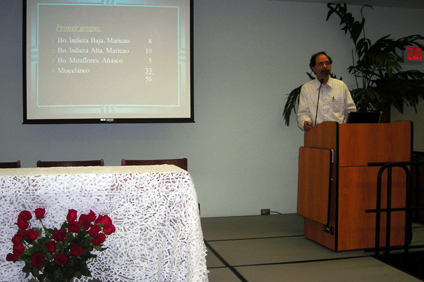
Doctor Juan Carlos Martínez Cruzado offered a conference about his research regarding the aspect of indigenous inheritance in DNA found in hairs from Puerto Rico.
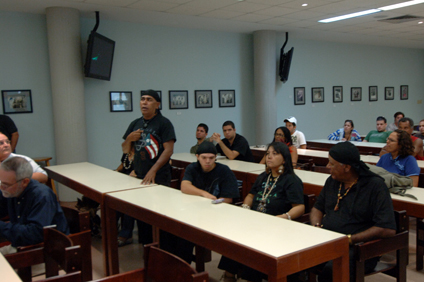
Members of the Martín Veguilla Company attended the conference.
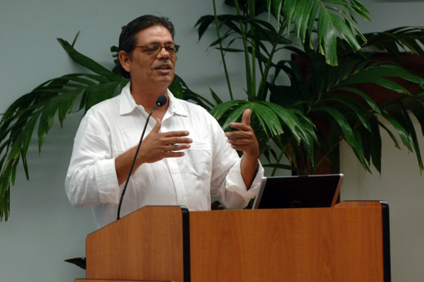
Archeologist Juan Rivera Fontán was in charge of the discussion on archaeology in Puerto Rico.
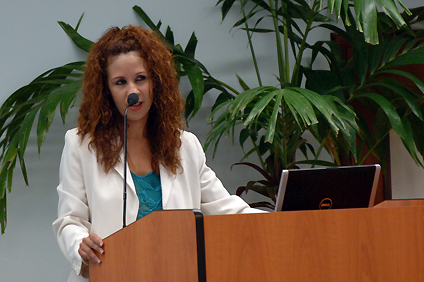
Doctor Mariam Ludim Rosa Vélez presented her sister Sonia M. Rosa Vélez's book, which includes a study done on the indigenous legends of Puerto Rico.
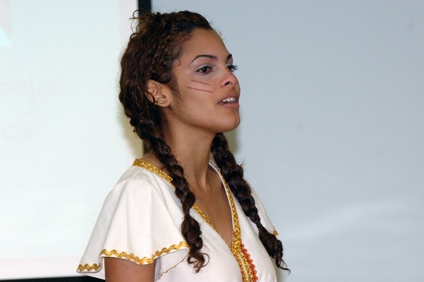 Zainex K. Hernández Rosa read a prayer in the indigenous language of the Taínos. Zainex K. Hernández Rosa read a prayer in the indigenous language of the Taínos.
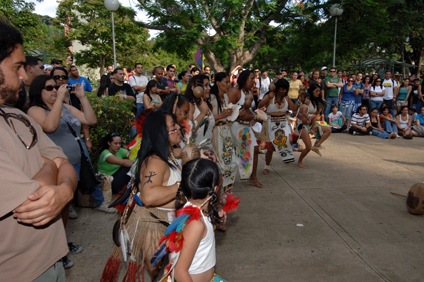
The symposium closed with an indigenous demonstration where 17 members of the Martín Veguilla Company simulated the traditional Taíno practices and dances.
Photographs by Carlos Díaz / UPRM Press
|

